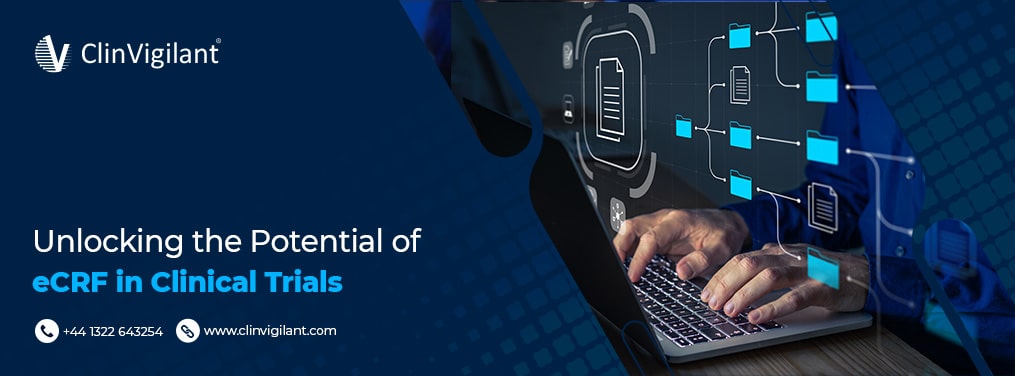
Unlocking the Potentials of eCRF in Clinical Trials
Electronic case report forms (eCRFs) have become an integral part of modern clinical trials. eCRFs allow for more efficient and accurate data collection compared to traditional paper-based data capture. In this blog post, we will explore what an eCRF is, the benefits of using eCRFs, best practices for setting up an eCRF system, types of data collected, security considerations, eCRF design, and frequently asked questions.
What is an eCRF?
An electronic case report form (eCRF) in clinical trials to collect data from study participants in an electronic format. eCRFs are used to record study data like demographics, medical history, observations, adverse events, and other information required by the clinical trial protocol.
Whereas paper case report forms (pCRFs) require manual data entry and are prone to errors, eCRFs allow for real-time data capture and validation checks to improve data quality. The eCRF data is stored directly on a clinical data management system.
Benefits and Advantages of eCRF
The use of eCRFs provides many benefits over traditional paper-based data collection:
- Improved data accuracy: eCRFs have built-in logic checks and validation rules to detect discrepancies and reduce errors during data entry. This improves overall data integrity.
- Faster data retrieval: eCRF data is available for review and analysis in real-time via reporting dashboards. This enables faster data queries and clinical trial oversight.
- Enhanced workflow: eCRFs are designed to mirror the study workflow with easy navigation and prompts to guide site staff. This optimizes site performance.
- Real-time access: Clinical monitors and study coordinators can access eCRF clinical trial data remotely via any internet-connected device. This allows for better collaboration and rapid issue resolution.
- Cost and resource savings: eCRFs eliminate the need for paper printing, archiving, and shipping. They also require less on-site monitoring for source data verification. This leads to significant cost savings.
- Regulatory compliance: eCRF software has audit trail capabilities to record data changes, user actions, and timestamps. This supports inspection readiness.
- Participant convenience: eCRFs allow study participants to directly enter their experiences and symptoms electronically for more convenient and accurate reporting.
Electronic Data Capture in Clinical Trials
Electronic data capture (EDC) refers to the use of eCRF for clinical trials data electronically. EDC has become the expected standard, with over 90% of trials using some form of EDC system.
EDC software provides eCRF templates that can be customized for each study protocol. Study data fields are set up to only accept valid data types and ranges, with real-time error checking. EDC systems also include capabilities for query management, audit trails, reporting, and data exports.
Centralized hosting of the EDC application and database also allows study teams and sponsor access to the same dataset for up-to-date data review and analysis. This improves efficiency compared to the process of collecting paper CRFs for data entry and cleaning.
Many EDC platforms also allow integration with other eClinical systems like CTMS, ePRO, IVRS, and safety databases. This enables a unified data flow and analytics environment for clinical trials.
Best Practices for Setting Up an eCRF
To maximize the benefits of eCRFs, it is important to optimize the design, setup, and ongoing management:
- Involve all study stakeholders in the design phase to ensure eCRFs capture the right data effectively.
- Design eCRFs to mirror the paper version to ease site adoption and training. Maintain consistency in styles and navigation.
- Set up edit checks, validations, and skip patterns early to improve compliance. Test rigorously.
- Ensure eCRFs are intuitive and easy to use on desktop and mobile devices. Simplicity enables quality data.
- Provide comprehensive training and reference materials to sites on eCRF completion and query resolution.
- Plan for real-time data review to identify issues early. Implement metrics for site performance monitoring.
- Configure patient-centric eCRFs and portals to enable direct ePRO data entry for patient convenience.
- Develop robust change control and versioning procedures to manage eCRF revisions after go-live.
- Archive eCRF data properly after study completion to meet security and compliance requirements.
Types of Data Collected with eCRF
eCRFs are highly versatile and can be configured to capture all types of clinical trial data required, including:
- Demographics like initials, age, gender, ethnicity, addresses, contact information.
- Medical history such as diagnoses, surgical procedures, medications, allergies.
- Details of study eligibility criteria, randomization, study drug assignment and dosing.
- Vital signs, physical exam findings, laboratory tests, image scan results.
- Patient reported outcomes like symptoms, pain scores, quality of life assessments collected via questionnaires.
- Diary entries by patients directly on the eCRF portal.
- Ratings and observations from site staff during patient visits.
- Records of adverse events, serious adverse events, concomitant medications and dosing changes.
- Details of protocol deviations, violations, and discontinuations from the study.
- Study closeout and outcome data.
The extensive configuration options allow tailored eCRFs to be designed to capture all relevant data points required for the trial.
Security Considerations for an eCRF System
Maintaining data privacy and security is critical when implementing an eCRF and EDC system. Important security considerations include:
- Role-based access control and permissions to limit access to only authorized users.
- Unique username and password requirements, with forced password resets and timeouts.
- Multi-factor authentication for enhanced user identity validation before system access.
- Use of modern encryption standards to protect sensitive and personal data in transit and at rest.
- Frequent data backups and availability of secondary failover server clusters to prevent data loss.
- Validation checks on correct patient ID and trial site to prevent data being recorded on wrong subjects.
- Detailed audit trail capability to document a complete record of user actions within the system.
- Plans and policies for disaster recovery and business continuity in case of a security breach or system outage.
- Testing for vulnerabilities, data leaks, intrusions and cybersecurity readiness by independent auditors.
- Training site staff on data privacy responsibilities and best practices for access and handling of eCRF data.
How to Design eCRFs
The optimal design of eCRFs is key to maximizing data quality and site compliance on clinical trials. Here are some best practices to follow when designing eCRFs:
- Involve all study team members like clinical operations, data management, biostatistics and medical in the planning process.
- Ensure eCRFs match the paper CRF flow, style and question ordering to allow sites to follow a familiar workflow.
- Group related data fields into logical sections and use tabs for better organization and navigation.
- Reduce free text fields and use dropdown selections, checkboxes and radio buttons for standardized data entry.
- Implement skip patterns and branching logic to avoid redundant data entry.
- Set up front-end field validations and error messages to prevent incorrect entries.
- Build reporting-friendly structured data capture options like date pickers and drop-downs.
- Utilize user experience (UX) principles optimized for desktop and mobile devices.
- Configure patient-friendly ePRO sections and portals for direct data capture.
- Allow site comments on eCRFs to capture contextual information.
- Enable real-time data review and metrics to identify issues and improve ongoing designs.
Conclusion
eCRFs and EDC systems have become indispensable for clinical trials due to the many benefits they offer for data quality, study efficiency, patient convenience and cost savings. However, thoughtfully planning and optimally designing eCRFs is vital for realizing these benefits. With a collaborative approach, intuitive interface, robust validations, and user-centric testing, eCRFs can unlock significant potentials and value for clinical trials. Utilizing eCRF best practices will lead to successful trial outcomes in the era of digital data capture.
FAQs
Q: What are some key benefits of using eCRFs?
A: Key benefits are real-time data access, improved accuracy via validations, remote monitoring capability, time and cost savings, patient convenience features, and audit trail documentation.
Q: How are eCRFs designed and tested?
A: eCRF forms are designed collaboratively by all study team members. They undergo rigorous testing to validate logic, configurations and ease of use. Changes are strictly controlled after go-live.
Q: What type of data is collected on eCRFs?
A: eCRFs collect all protocol required data – demographics, medical history, study drug details, vital signs, labs, patient reported outcomes, adverse events etc.
Q: How does eCRF software ensure data privacy and security?
A: Security measures like encryption, access controls, passwords, multi-factor authentication and auditing safeguard eCRF data integrity and subject privacy.
Q: What are some best practices for using eCRFs effectively?
A: Best practices include intuitive design, extensive validations, comprehensive training, issue tracking, optimized UX, patient ePRO portals, and change controlled revisions after go-live.

